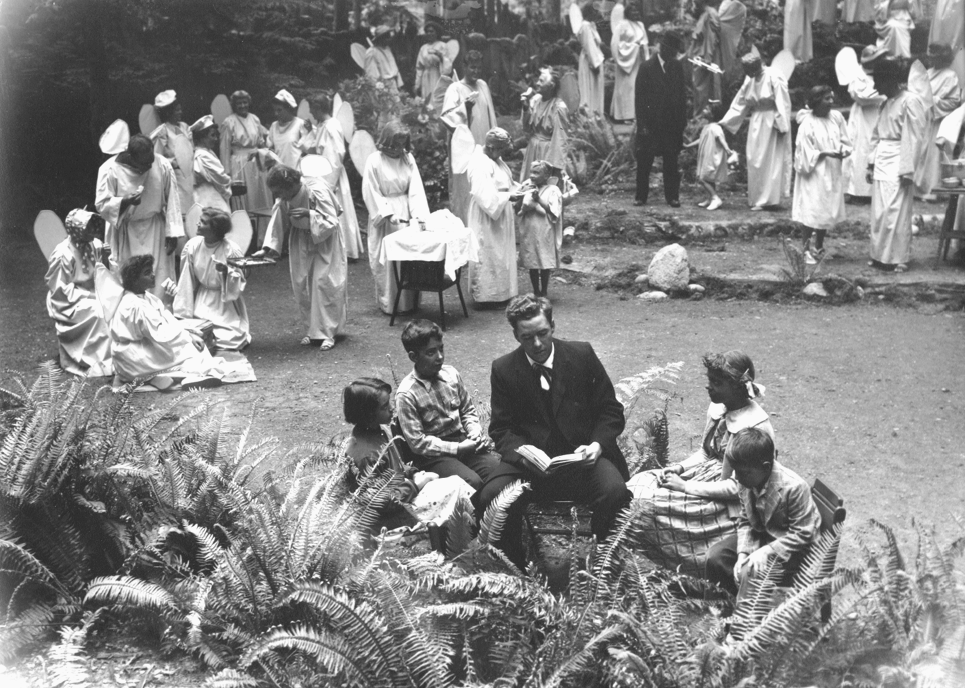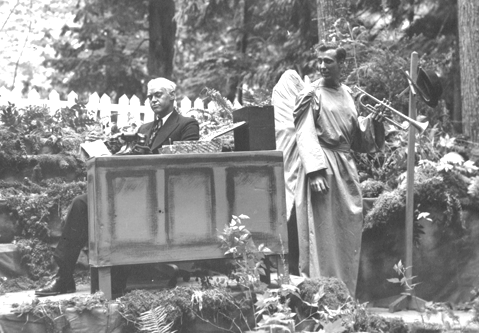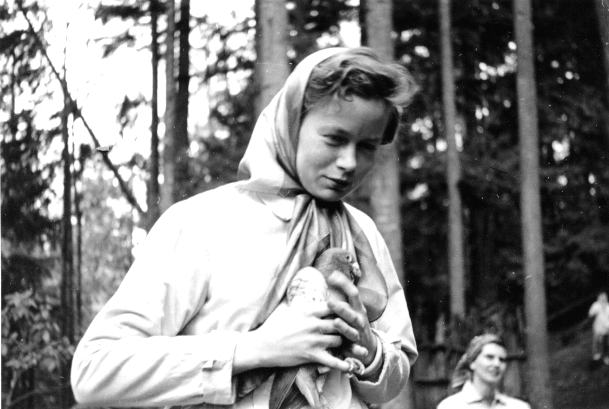June 5, 11, 12, 1955
 Opening in the Louisiana Sunday School of the Reverend Deshee, Green Pastures narrates the highlights of Old Testament stories as conceived in simple folklore. "Back in dem days de Lawd walked de earth a natchel man. He made mighty men, but he was above dem all." A rich but always reverent humor pervades the play. Written by Marc Connelly, based on Roark Bradford's Ol' Man Adam an' His Chillun, Green Pastures won a Pulitzer Prize for the best Drama of 1930 which "represent(ed) the educational value and power of the stage."
Opening in the Louisiana Sunday School of the Reverend Deshee, Green Pastures narrates the highlights of Old Testament stories as conceived in simple folklore. "Back in dem days de Lawd walked de earth a natchel man. He made mighty men, but he was above dem all." A rich but always reverent humor pervades the play. Written by Marc Connelly, based on Roark Bradford's Ol' Man Adam an' His Chillun, Green Pastures won a Pulitzer Prize for the best Drama of 1930 which "represent(ed) the educational value and power of the stage."
In the show, when "de Lawd" created some firmament, orange smoke signal flares were set off. A newspaper reported "the audience was patient while the smoke drifted away, coughing only slightly while they waited."
 Noah and his family, on the Ark, sent a dove to seek land. For this scene, the players used some borrowed homing pigeons. In rehearsal one flew straight home, but during one performance the bird flew up and perched in a tree behind the stage. Director Earl Kelly said he was complimented that it enjoyed the show so much it wanted to watch it.
Noah and his family, on the Ark, sent a dove to seek land. For this scene, the players used some borrowed homing pigeons. In rehearsal one flew straight home, but during one performance the bird flew up and perched in a tree behind the stage. Director Earl Kelly said he was complimented that it enjoyed the show so much it wanted to watch it.
For the miracle of the "burning bush" that was not consumed, Morris Moen connected a short piece of pipe with holes drilled in it, to a tank of propane gas. The pipe was placed inside a cylinder of wire screen, with bushes on the outside which the flames wouldn't reach. During intermission a stagehand walked on stage, lit the gas very low, not visible from the audience. On cue, the gas valve was opened further and the bush apparently burst into flames without burning up.
Morris made Aaron's rod that turns into a snake from a rod cut into "vertebrae," shaped so one would fit into the end of the next. He ran a cable through the center of the vertebrae attached at one end. At the other end the cable was attached to a lever so it could be locked in position. When the lever was released, elastic bands on alternate sides of the vertebrae joints pulled the vertebrae into snake-like curves. In its first scene in the play, De Lawd demonstrated it to Aaron's brother, Moses. As De Lawd released the lever to make it a snake, he placed a small loop on the end over a hook on the ground which was tied to a string. The snake was pulled offstage, getting quite a reaction from the audience.
 "Probably the most miraculous event of all went unnoticed by the audience, much to the credit of Evan Sanders. At noon of the day preceding the first performance Evan was called upon to meet a sudden emergency and substitute in the role of Moses, one of the most substantial parts in the play. Not only did he learn the part in the next 24 sleepless hours but gave a convincing performance of this exacting role. Few people realized there had been a substitution and in the best theatrical tradition the show went on." [Ray E. Levine, The Mountaineer, 1955]
"Probably the most miraculous event of all went unnoticed by the audience, much to the credit of Evan Sanders. At noon of the day preceding the first performance Evan was called upon to meet a sudden emergency and substitute in the role of Moses, one of the most substantial parts in the play. Not only did he learn the part in the next 24 sleepless hours but gave a convincing performance of this exacting role. Few people realized there had been a substitution and in the best theatrical tradition the show went on." [Ray E. Levine, The Mountaineer, 1955]
Makeup presented challenges. In a move considered daring at the time and probably impossible for a community theater group today, Kelly decided to follow the script recommendation to perform in blackface.
The angel choir in this production was composed of members of the Seattle Chorale, directed by Leonard Moore. Many "angels" also sang in church choirs, and from church they would "make a dash for the ferry and come panting down the trail to the Theatre, with a scant ten minutes to spare for costuming, make up and if they were lucky, catching their breath in time for the first chorus." [Ray E. Levine, The Mountaineer, 1955]
Early in the play, Cain kills Abel, and director Kelly had to figure out how to get him offstage. This is easy indoors. The curtain comes down, or the houselights go dark. Lacking a curtain or lights, Kelly asked the angel choir to softly sing "Swing Low, Sweet Chariot," then he had "De Lawd" walk on stage, touch Abel on the shoulder and walk off, and Abel followed him "home."
About 2,400 people turned out to see the play. The record-size cast of 93 actors played 235 roles.
